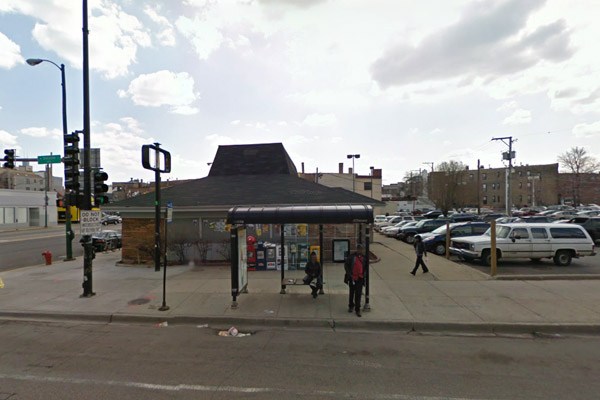
With the Bloomingdale Trail and Navy Pier reaching significant milestones in their re/development, Chicago's future civic landscape is getting national attention. But I took particular note of one less sexy development, being a regular piece of the city as I experience it: the old Pizza Hut lot at the Polish Triangle (Milwaukee/Division/Ashland).
Designed by the noted firm of Wheeler Kearns Architects, the building has an unusual faceted façade made up of metal panels which randomly alternate with floor to ceiling window openings. Each side of the building is inflected slightly to create a vertical crease dividing each façade into two surfaces slightly out of plane with each other. As the sun moves across the sky, each plane will catch the light differently, enlivening the surface of the building. It is a very thoughtful and elegant solution that will create an ever-changing play of light and shadow.
For years, it was a Pizza Hut; more recently, it was the boarded-up shell of a Pizza Hut serving as a magnet for gig posters and street art. Now it's a vacant lot, but not for lack of trying; the piece above is a good account of why such places can remain vacant despite being at significant social and transportaton hubs. From the renderings, it appears to be an elegant solution for the corner, particularly by the standards of new development in the neighborhood. It's certainly an improvement over the hotel-chic condo building across the street. As you might expect, the big beef was curb cuts and drive-thrus:
The bank will have two drive-thru lanes entered from the existing alley on Division Street, and exiting onto Ashland across an existing curbcut at the south corner of the site. The presence of the drive-thru was very controversial and represents the only significant concession on the part of the community. Unlike other bank proposals for the site, this one added no additional curbcuts, had fewer drive-through lanes, contained additional non-bank retail on the ground floor and had commercial and residential space above.
In other good news on Division Street, the recently decommissioned Post Office a block from the Polish Triangle—poorly regarded as a Post Office, but one I had a lot of affection for as a piece of ugly-ducking bureaucratic modernism—is under development as a gym.
* ArtInfo grades several attempts to catch the High Line magic; the Bloomingdale Trail gets a solid seven. I'm a fan of the Low Line, which reminds me of the wonders that urbanist hackers UX have been perpetrating in Paris over the past three decades.
* An even more ambitious project than the High Line or the Bloomingdale Trail, the Tappan Zee bridge greenway, is apparently DOA, which is a shame.
* The Tappan Zee proposal reminded me of something I noticed when I finally got around to watching The Naked City, Jules Dassin's great noir:
One scene that I took note of during this film was the final chase scene on the Williamsburg Bridge. The transformation of the Williamsburg Bridge from then to now is pretty fascinating. The West bound side has incoming and outgoing traffic, and the current eastbound side has a stairway that leads to the walkway. The most striking difference is how folks back then (Assuming that this portrayal was true to life.) utilized the Manhattan side walkway as a park. You can see kids rollerskating, jumping rope, playing marbles, etc. The only bridge in NY that bears any resemblance to that now is the Brooklyn Bridge. However the Williamsburg Bridge 1948 seems to have been a playground for locals as opposed to the tourists who cross the Brooklyn Bridge now.
At the time, a plaza covered the Manhattan approach to the bridge. All that's gone, given way to car traffic, and all that's left is a functional pedestrian passageway where what must have been a wonderful place to spend an afternoon used to be. (Yes, the old Williamsburg Bridge plaza was, to me, the biggest shock of the murder mystery.)
* Speaking of the Bloomingdale Trail, one piece that's coming along is the gateway parks—here's what the one at Milwaukee and Leavitt will look like.
* Uptown Update has a good rundown of the Wilson El Station restoration, which includes restoration of the Gerber Building and its clock. It's so named because it's one of the designs of architect Arthur Gerber, who designed many of Chicagoland's best transit stations.
Photograph: Google Street View



